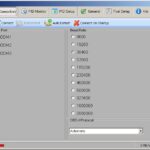A common issue in Volkswagen (VW) vehicles is the Diagnostic Trouble Code (DTC) U112100, which indicates a communication problem between the transmission control module and other control units in the car. This article delves into the U112100 code, its potential causes, symptoms, and diagnostic approaches.
What is VW DTC U112100?
The U112100 fault code specifically points to a “no signal/communication” error originating from the transmission control module, often labeled as “Getriebe_11” in diagnostic scans. This essentially means that the transmission control module is not communicating correctly with the other modules in the vehicle’s network, potentially through the CAN bus system. This lack of communication can lead to various drivability issues and warning lights.
Potential Causes of U112100
Several factors can contribute to the U112100 error:
- Wiring Issues: Damaged, corroded, or loose wiring harnesses connecting to the transmission control module are a common culprit. This could include damaged CAN bus wires.
- Faulty Connectors: Similar to wiring problems, faulty connectors at the transmission control module can disrupt communication.
- Malfunctioning Transmission Control Module (TCM): A defective TCM itself can be the root cause, failing to send or receive signals properly.
- Low Battery Voltage: Insufficient battery voltage can interfere with module communication across the vehicle network. While less common, a failing battery or charging system should be ruled out.
- Software or Programming Issues: In rare cases, outdated or corrupted software within the TCM might contribute to the problem.
Symptoms Associated with U112100
The symptoms associated with U112100 can vary depending on the specific VW model and the extent of the communication failure. Some common indicators include:
- Check Engine Light or Warning Lamps: The illumination of the check engine light or other warning lights related to the transmission or vehicle stability systems is a common sign.
- Transmission Shifting Problems: Rough shifting, delayed engagement, or inability to shift gears can occur due to communication breakdown. This might manifest as slipping, harsh shifts, or getting stuck in a particular gear.
- Limp Mode: In severe cases, the vehicle might enter a “limp mode” to prevent further damage. This limits engine power and speed to allow the driver to safely reach a service center.
- Reduced Fuel Economy: Communication issues can disrupt optimal engine and transmission operation, leading to decreased fuel efficiency.
- Erratic Vehicle Behavior: Other unpredictable behaviors like stalling, loss of power, or unexpected acceleration might be observed.
Diagnosing U112100
Diagnosing the U112100 code requires a systematic approach:
- Retrieve Fault Codes: Use a diagnostic scanner (such as VCDS) to read all stored DTCs. This will confirm the presence of U112100 and potentially reveal other related codes.
- Visual Inspection: Carefully inspect the wiring harness and connectors leading to the TCM for any signs of damage, corrosion, or loose connections.
- Battery Voltage Check: Verify that the battery voltage is within the specified range. A low battery can cause numerous communication problems.
- Check for Technical Service Bulletins (TSBs): Consult VW’s technical service bulletins to see if there are any known issues or solutions related to U112100 for your specific model year.
- Advanced Diagnostics: If the problem persists, more advanced diagnostic procedures might be necessary. This could include testing the CAN bus communication network using specialized tools. This may also involve checking individual module voltages and grounds.
- Professional Assistance: If the issue remains unresolved after basic troubleshooting, it’s highly recommended to consult a qualified VW technician for further diagnosis and repair.
Addressing the U112100 fault code promptly is crucial to ensure the safe and reliable operation of your VW vehicle. While basic troubleshooting can sometimes resolve the issue, professional assistance is often necessary for accurate diagnosis and effective repair.


